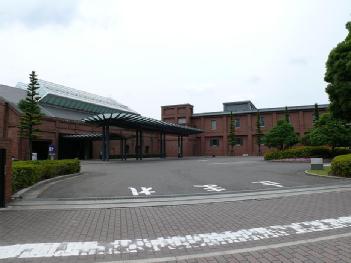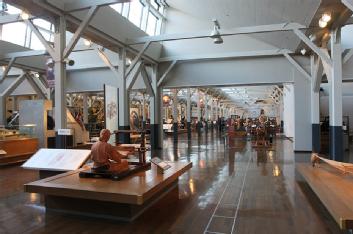
    |
Toyota Commemorative Museum of Industry and Technology
|
451-0051 Nagoya, Japan |
|
| Address |
1-35, Noritake Shinmachi 4-chome
Nishi-ku 名古屋市西区則武新町 4-1-35 |
| Floor area | only roughly guessed: 25 000 m² / 269 098 ft² |
Passenger cars
- Steam engines/generators/pumps
- Robotic
- Automation Control Systems
- Textile production
- Trucks / Lorries
- Physics
|
Opening times
|
Tuesday - Sunday: 9:30am - 5:00pm | ||||
|
Status from 01/2021
|
Adults: 500 yen; Students: 300 yen; Elementary school students: 200 yen | ||||
| Contact |
|
||||
| Homepage |
www.tcmit.org/ www.tcmit.org/english/ |
||||
トヨタテクノミュージアム産業技術記念館 in Nagoya, Japan, is not yet administrated by a Radiomuseum.org member. Please write to us about your experience with this museum, for corrections of our data or sending photos by using the Contact Form to the Museum Finder.
| Location / Directions |
Railways(Meitetsu) 3 minute walk from Sako Station on the Nagoya Line Railways(JR and Kintetsu) 25 minute walk or 5 minutes by car from Nagoya Station Bus Board the Nagoya Station bus at the Nagoya Station Platform No. 11; 3 minute walk from the TOYOTA Commemorative Museum of Industry and Technology stop. Or board the Nagoya Sightseeing Route Bus Me~guru at the Nagoya Station Platform No. 8; get out in front of main entrance of the TOYOTA Commemorative Museum of Industry and Technology stop. Subway 10 minute walk from the No. 2 exit of Kamejima Station on the Higashiyama Line |
| Description | Entrance LobbyThe lobby houses a rest corner and leads directly to the Room of Fame, a restaurant, and the Video Library. Textile Machinery PavilionThis spacious floor of more than 3,468 ㎡ was originally built as a cotton-spinning factory in the Taisho Period (1912-1926) and the building itself is as it was way back then. The displays introducing the changes that have occurred in motive power, as well as configuration models and approximately 95 different spinning and weaving machines, give you a clear command of the technical progress that has taken place over the years. Automobile PavilionTake a long look at this 7,900 sq. meter expanse; it’s as if a huge sports gym was turned into an automotive factory! Examine the detailed exhibitions of Automobile Mechanisms and Component Parts, Automotive Technology, Manufacturing Technology. Observe actual machinery operations, cross-cut component models (with viewer control buttons), experimental apparatus, and production equipment. Enjoy the clear and easy-to-understand automotive demonstrations with realistic visual and audio effects. Creative WorkshopThis building is part of the Kariya Iron Working Shop belonging to Toyoda Automatic Loom Works, Ltd. that was built in 1926 for the full-scale production of the Type G Automatic Loom. Steam EngineAfter its manufacture in 1898, this steam engine was used in a German spinning mill. It was modified in 1902 to generate electrical power and moved to a saw mill near Stuttgart. Toyota Group BuildingThe former head office of Toyoda Spinning & Weaving Co., Ltd., originally constructed in 1925, has been completely restored and holds many of Sakichi and Kiichiro Toyoda’s personal belongings and papers. Toyoda Shokai OfficeSakichi Toyoda established ”Toyoda Shokai Office” in 1902 as a company for inventing, researching and developing the automatic loom. This building itself was built in 1905 and was both the residence and the work place for Sakichi, the place where he devoted all his time and energy into developing the automatic loom. |
| Description (other) |
設立の目的トヨタグループの共同事業として設立した産業技術記念館は、豊田佐吉が明治44年に自動織機の研究開発のために創設した試験工場の場所と建物を利用して建設しました。 館の創設と基本理念産業技術記念館は、1994年6月、名古屋市西区・栄生の地に開館しました。往時の様子をとどめる豊田自動織機栄生工場(トヨタ自動車工業より移譲)を産業遺産として保存しながら、近代日本の発展を支えた基幹産業の一つである繊維機械と、現代を開拓し続ける自動車の技術の変遷を通して、日本の産業技術史について次代を担う人たちへ系統的に紹介するための施設です。 |
[dsp_museum_detail.cfm]
| Data Compliance | More Information |





